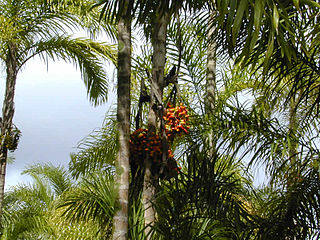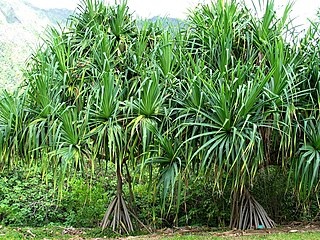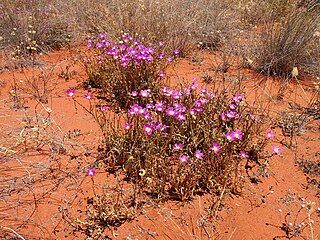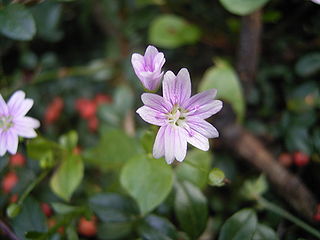
The Rubiaceae are a family of flowering plants, commonly known as the coffee, madder, or bedstraw family. It consists of terrestrial trees, shrubs, lianas, or herbs that are recognizable by simple, opposite leaves with interpetiolar stipules and sympetalous actinomorphic flowers. The family contains about 13,500 species in about 620 genera, which makes it the fourth-largest angiosperm family. Rubiaceae has a cosmopolitan distribution; however, the largest species diversity is concentrated in the tropics and subtropics. Economically important genera include Coffea, the source of coffee, Cinchona, the source of the antimalarial alkaloid quinine, ornamental cultivars, and historically some dye plants.

Oleaceae, also known as the olive family or sometimes the lilac family, is a taxonomic family of flowering shrubs, trees, and a few lianas in the order Lamiales. It presently comprises 28 genera, one of which is recently extinct. The extant genera include Cartrema, which was resurrected in 2012. The number of species in the Oleaceae is variously estimated in a wide range around 700. The flowers are often numerous and highly odoriferous. The family has a subcosmopolitan distribution, ranging from the subarctic to the southernmost parts of Africa, Australia, and South America. Notable members include olive, ash, jasmine, and several popular ornamental plants including privet, forsythia, fringetrees, and lilac.

Mahonia is a formerly accepted genus of approximately 70 species of shrubs or, rarely, small trees with evergreen leaves in the family Berberidaceae, native to eastern Asia, the Himalaya, North America, and Central America. They are closely related to the genus Berberis and as of 2023 the majority of botanical sources list it as a synonym for Berberis.

The water-plantains (Alismataceae) are a family of flowering plants, comprising 20 genera and 119 species. The family has a cosmopolitan distribution, with the greatest number of species in temperate regions of the Northern Hemisphere. Most of the species are herbaceous aquatic plants growing in marshes and ponds.

Ochnaceae is a family of flowering plants in the order Malpighiales. In the APG III system of classification of flowering plants, Ochnaceae is defined broadly, to include about 550 species, and encompasses what some taxonomists have treated as the separate families Medusagynaceae and Quiinaceae. In a phylogenetic study that was published in 2014, Ochnaceae was recognized in the broad sense, but two works published after APG III have accepted the small families Medusagynaceae and Quiinaceae. These have not been accepted by APG IV (2016).

Babiana is a genus of geophytes in the family Iridaceae with 93 recognized species as of March 2022. The leaves consist of a stalk and a blade that are at an angle to each other. The leaf blades are entire, laterally flattened and pleated, and often hairy. Each individual flower is subtended by two hairy or smooth bracts that are green in most species. The outer bract is often the largest of the two. In most species the bracts have a dry, brown tip, but in a few species it is entirely green or entirely dry when flowering or the outer bract is translucent and has a papery texture. The inner bract is forked or split all the way to its base. Each flower is without a pedicel, with six tepals that are merged at their base into a tube and form a perianth that is mirror-symmetrical in most species, with three anthers implanted where the perianth tube widens and that are, in almost every species, clustered at one side of the style. The style has three branches that widen towards the tip and the ovary is inferior. Flowers occur in almost every conceivable colour, many have markings on some of the tepals, and few star-symmetrical flowers have a centre that strongly contrasts with the free part of the perianth. The majority of these species are endemic to the west and southwest of South Africa, and southwestern Namibia, but one species occurs elsewhere in Namibia and South Africa and another species can be found in Botswana, Namibia, South Africa, Zambia and Zimbabwe. The genus name is derived from the Dutch word baviaan, referring to the Chacma baboon, Papio ursinus, that consumes the corms of plants in the genus. The genus is called bobbejaantjie in Afrikaans, meaning small baboon.

Bactris is a genus of spiny palms which are native to Mexico, South and Central America and the Caribbean. Most species are small trees about 2 m tall, but some are large trees while others are shrubs with subterranean stems. They have simple or pinnately compound leaves and yellow, orange, red or purple-black fruit. The genus is most closely related to several other spiny palms—Acrocomia, Aiphanes, Astrocaryum and Desmoncus. The fruit of several species is edible, most notably B. gasipaes, while others are used medicinally or for construction.

Calandrinia is a large genus of flowering plants known as purslanes and redmaids. It includes over 100 species of annual and perennial herbs which bear colorful flowers in shades of red to purple and white. Plants of this genus are native to Australia, western South America, Central America, and western North America. Some species have been introduced to parts of New Zealand, southern Africa, Asia, and Europe.

Peridiscaceae is a family of flowering plants in the order Saxifragales. Four genera comprise this family: Medusandra, Soyauxia, Peridiscus, and Whittonia., with a total of 12 known species. It has a disjunct distribution, with Peridiscus occurring in Venezuela and northern Brazil, Whittonia in Guyana, Medusandra in Cameroon, and Soyauxia in tropical West Africa. Whittonia is possibly extinct, being known from only one specimen collected below Kaieteur Falls in Guyana. In 2006, archeologists attempted to rediscover it, however, it proved unsuccessful.

Pandanaceae is a family of flowering plants native to the tropics and subtropics of the Old World, from West Africa through the Pacific. It contains 982 known species in five genera, of which the type genus, Pandanus, is the most important, with species like Pandanus amaryllifolius and karuka being important sources of food. The family likely originated during the Late Cretaceous.

Ruppia, also known as the widgeonweeds, ditch grasses or widgeon grass, is the only extant genus in the family Ruppiaceae, with eight known species. These are aquatic plants widespread over much of the world. The genus name honours Heinrich Bernhard Rupp, a German botanist (1688-1719). They are widespread outside of frigid zones and the tropics.

Anemonastrum canadense, synonym Anemone canadensis, the Canada anemone, round-headed anemone, round-leaf thimbleweed, meadow anemone, windflower, or crowfoot, is a herbaceous perennial flowering plant in the family Ranunculaceae. It is native to moist meadows, thickets, streambanks, and lakeshores in North America, spreading rapidly by underground rhizomes. It is valued for its white flowers.

Calycanthus floridus, or commonly known as the eastern sweetshrub, Carolina all spice, or spicebush, is a species of flowering shrub in the family Calycanthaceae. It is identifiable by its dark red flowers and fragrant scent. It is non-invasive and is found in the Southeastern United States region. The Nature Conservancy considers its conservation status to be G5, globally secure, indicating it is at low risk of extinction. It is presumed to have been extirpated from Ohio.

Rumicastrum balonense, synonym Calandrinia balonensis, is a succulent plant native to arid and semi-arid regions of Australia.

Aegialitis is a genus of two shrubby mangrove species, with one native to Southeast Asia and the other native to Australia and Papua New Guinea.

In botany, a whorl or verticil is a whorled arrangement of leaves, sepals, petals, stamens, or carpels that radiate from a single point and surround or wrap around the stem or stalk. A leaf whorl consists of at least three elements; a pair of opposite leaves is not called a whorl.

Montiaceae are a family of flowering plants, comprising about 14 genera with about 230 known species, ranging from small herbaceous plants to shrubs. The family has a cosmopolitan distribution.

Rumicastrum corrigioloides is an annual herb in the family Montiaceae, and is native to Western Australia, South Australia, and Victoria.

Rumicastrum granuliferum is an annual herb in the family Montiaceae, and is native to New South Wales, Tasmania, Western Australia, South Australia, and Victoria.

Condylocarpon guyanense is a species of plant in the Apocynaceae family. It is native to Brazil, French Guiana, and Guyana. René Louiche Desfontaines, the botanist who first formally described the species, named it after Guyana where Joseph Martin collected the specimen he examined.





















